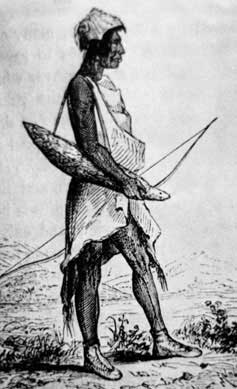 |
Previous Issues |
| Cedar Mill Community Website |
|
| About Cedar Mill News |
|
||||||
| Volume 6, Issue 8 | August 2008 |
|||||
History in the News
|
 |
| Sketch of Kalapuya man drawn by Alfred Agate, a member of the Wilkes Expedition in 1841. |
The Indians who resided in and around the Cedar Mill area called themselves the Atfalati although the settlers eventually called them Tualatin and some referred to them as “Wapato Lake Indians.” They spoke Tualatin, one of three languages of the Willamette Valley Kalapuyan group. Roaming from the Willamette River to the slopes of the Coast Range and from present day Wilsonville to the Columbia River, they hunted game and harvested wild plants in Cedar Mill near their Beaverton summer village, Chakepi, meaning “Place of Beaver.”
White men entering the region found most upper-class Tualatins had flattened foreheads. Infants were bound on cradleboards for nearly a year, to achieve the desired results.
The adults used feathers to adorn their hair, and sea shells and trade beads were hung from pierced noses and ears. Women braided their hair and wore simple blouses or aprons of hide, grass and cedar bark. The men frequently went naked during the warm months. In winter the Atfalati added rawhide leggings, moccasins and furs for warmth.
Permanent winter villages consisting of long houses built from cedar planks were built around Wapato Lake, Beaverton, Forest Grove and Hillsboro. Two to five families shared 40-50 foot-long buildings constructed with cedar planks, earthen sides and bark roofs. In addition, many villages included a special council house for important meetings and ceremonies. During the winter, the Atfalati lived on foods harvested and preserved during the summer months.
A plentiful supply of wild berries grew on the William Walker donation land claim near Cedar Mill, and for many years following Walker’s settlement he allowed Indians to harvest the wild fruit on his acreage. Farmers in Cedar Mill recovered a number of Indian artifacts, including arrowheads and at least one small mortar, probably used during the summer harvest season.
Prior to 1782, the Tualatin population may have exceeded several thousand but early European coastal explorers introduced smallpox and other diseases. Malaria raged from 1830-1833 and whole bands perished. By 1842 it was estimated the entire Kalapuyan population including the Tualatins numbered 600 people. After many treaties made and broken by the US government, survivors were eventually moved to the Grand Ronde Reservation where the 1890 census numbered the Tualatins at 28. The last known speaker of the Tualatin language, Louis Kenoyer, died in 1936.
More information is available in Cedar Mill History, which is now out of print but is available in the library. Another interesting book on the subject, The Indians of Western Oregon, by Stephen Dow Beckham, is also there. A survey of the languages of Oregon Indians is online at www.lanecc.edu/library/don/orelang.htm.
Cedar Mill Business Association
Published monthly by Cedar Mill Advertising & Design
Publisher/Editor:Virginia Bruce
503-629-5799
12110 NW West Rd
Portland, OR 97229